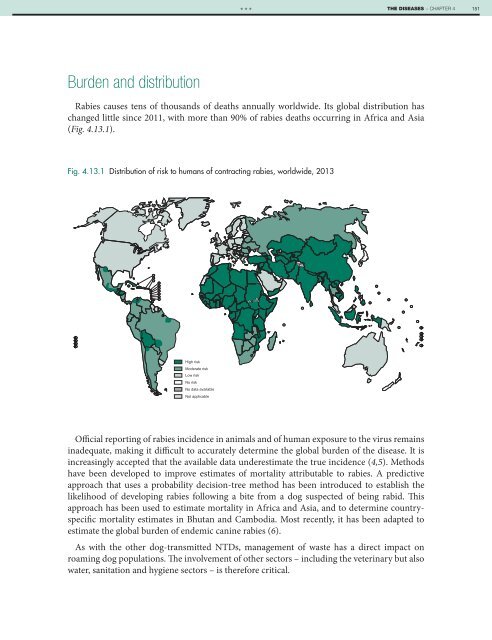1A9bnbK
1A9bnbK
1A9bnbK
You also want an ePaper? Increase the reach of your titles
YUMPU automatically turns print PDFs into web optimized ePapers that Google loves.
***<br />
THE DISEASES − CHAPTER 4<br />
151<br />
Burden and distribution<br />
Rabies causes tens of thousands of deaths annually worldwide. Its global distribution has<br />
changed little since 2011, with more than 90% of rabies deaths occurring in Africa and Asia<br />
(Fig. 4.13.1).<br />
Fig. 4.13.1 Distribution of risk to humans of contracting rabies, worldwide, 2013<br />
High risk<br />
Moderate risk<br />
Low risk<br />
No risk<br />
No data available<br />
Not applicable<br />
Official reporting of rabies incidence in animals and of human exposure to the virus remains<br />
inadequate, making it difficult to accurately determine the global burden of the disease. It is<br />
increasingly accepted that the available data underestimate the true incidence (4,5). Methods<br />
have been developed to improve estimates of mortality attributable to rabies. A predictive<br />
approach that uses a probability decision-tree method has been introduced to establish the<br />
likelihood of developing rabies following a bite from a dog suspected of being rabid. This<br />
approach has been used to estimate mortality in Africa and Asia, and to determine countryspecific<br />
mortality estimates in Bhutan and Cambodia. Most recently, it has been adapted to<br />
estimate the global burden of endemic canine rabies (6).<br />
As with the other dog-transmitted NTDs, management of waste has a direct impact on<br />
roaming dog populations. The involvement of other sectors – including the veterinary but also<br />
water, sanitation and hygiene sectors – is therefore critical.


